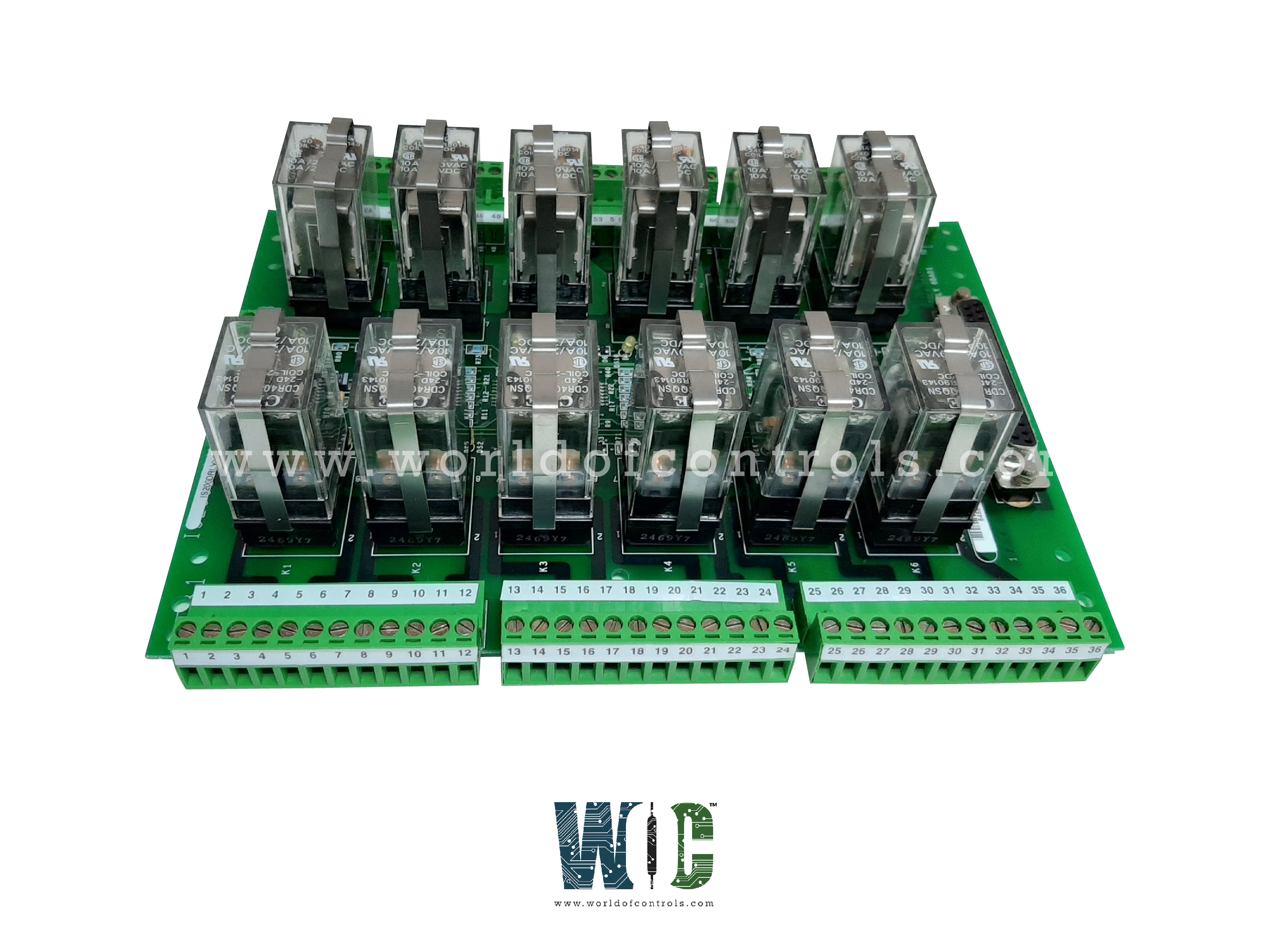SPECIFICATIONS
Part No.: IS200DRLYH1ACA
Manufacturer: General Electric
Country of Manufacture: United States of America (USA)
Number of relay outputs: 12
Size: 21.59 cm long x 20.57 cm wide
Temperature: 0 to 60 oC
Product Type: Simplex Relay Output Module
Availability: In Stock
Series: Mark VI
Functional Description
IS200DRLYH1ACA is a Simplex Relay Output Module developed by GE. It is a part of Mark VI control system. The board features 12 form-C dry contact output relays. Designed specifically for wall mounting rather than DIN-rail mounting, this board offers versatility in installation options to accommodate diverse system configurations. Connecting seamlessly to the VCCC or VCRC processor board via a single cable, the DRLY board simplifies the integration process, minimizing wiring complexity and streamlining system setup. The 37-pin cable connector employed by the board is identical to those utilized by the larger TRLY terminal board, ensuring compatibility and ease of connectivity across different components within the system architecture.
Installation
- Mounting: Begin by positioning the board on a metal plate designed to support its weight. The metal plate facilitates wall mounting of the board, providing stability and secure placement. Affix the board to the metal plate using four screws, ensuring a firm attachment that minimizes the risk of movement or displacement.
- Terminal Block Wiring: The board features 12 relay outputs, each connected to the odd-numbered screws on the terminal blocks. Utilize the high-density Euro-Block type terminal blocks provided with the board, plugging them into the numbered receptacles on the board. This arrangement allows for organized and efficient wiring of the relay outputs, streamlining the connection process.
- Chassis Ground Connection: Locate the two separate screws designated for the SCOM (chassis ground) connection on TB2 of the board. It is essential to establish a robust chassis ground connection to ensure proper grounding and electrical safety. Connect the chassis ground wires to these screws, ensuring that the connection is as short a distance as possible to minimize electrical resistance and enhance grounding effectiveness.
Operation
- Solenoid Source Power: It's important to note that the board does not include solenoid source power. This means that it relies on an external power source for operation.
- Relay Configuration: Each relay on the board is equipped with one set of dry contacts, featuring two normally open (NO) contacts arranged in series. This configuration offers flexibility in relay applications, allowing for versatile control of electrical circuits.
- Suppression and Monitoring: Unlike the TRLY board, the DRLY board does not include on-board suppression mechanisms or relay state monitoring capabilities. However, it still provides reliable relay functionality for various control applications.
- Power Supply: Receives 28 V dc power for the relay coils from the VCCC or VCRC. This power input is indicated by a green LED on the board, providing a visual confirmation of the power supply status.
- Coil Voltage Indication: Each relay on the DRLY board is equipped with a yellow LED that indicates the voltage across the coil. This LED serves as a visual indicator of the relay coil status, facilitating easy monitoring and troubleshooting.
- Default State: In the absence of a connected control cable, the relays on the DRLY board default to a de-energized state. This default state ensures safe operation and prevents unintended activation of relay contacts.
Fault Detection in I/O Board
- Monitoring P28 V DC State: The state of the P28 V DC power supply is continuously monitored using a green LED located at the top of the board. This LED serves as an indicator of the operational status of the power supply, providing visual feedback to operators. Monitoring the P28 V DC voltage ensures that the power supply is within the expected range, enabling timely identification of potential issues such as power supply failures or voltage fluctuations.
- Relay Coil Voltage Indication: Each relay coil voltage is monitored individually, and its state is indicated by a yellow LED. These LEDs provide visual feedback on the voltage across each relay coil, allowing operators to quickly assess the status of the relays. Monitoring relay coil voltages is essential for ensuring proper relay operation and detecting any abnormalities that may arise due to faults or malfunctions.
- Absence of Relay State Monitoring in VCCC or VCRC: It's important to note that there is no relay state monitoring in the VCCC (Voltage Controlled Current Controller) or VCRC (Voltage Controlled Relay Controller) sections of the I/O board. While other sections of the board are equipped with relay state monitoring for enhanced fault detection, the VCCC and VCRC sections do not feature this capability. Operators should be aware of this limitation and employ alternative methods for monitoring and detecting faults in these sections if necessary.
The WOC team is always available to help you with your Mark VI requirements. For more information, please contact WOC.
Frequently Asked Questions
What is IS200DRLYH1ACA?
It is a simplex relay output module developed by GE under the Mark VI series.
What happens if there's a mismatch with the terminal board connector ID?
If the terminal board connector ID does not match the expected values, a hardware incompatibility fault is triggered. This ensures that any discrepancies in the board identification are promptly detected and addressed.
How is the voltage across each relay coil indicated?
The voltage across each relay coil is visually indicated by a yellow LED on the board. This LED provides a quick and easy way to monitor the voltage status of the relay coils, aiding in troubleshooting and maintenance tasks.
How is the 28 V supply to the board indicated?
The presence of the 28 V supply to the board is signaled by a green LED. This LED serves as a visual indicator of the power supply status, confirming that the board is receiving the necessary voltage for proper operation.
